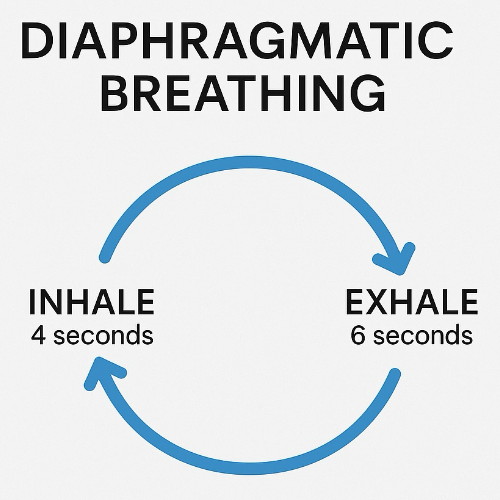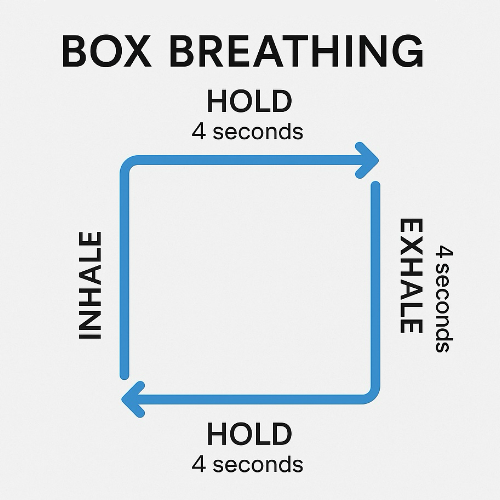Breathwork 101: How to Practice Diaphragmatic and Box Breathing for Stress, Healing, and Consciousness Growth
“When we build a relationship with our breath, we are returning to the ground, safe, authentic self that dwells within each of us.”
“I watch how consciousness moves in and out of the body from the moment of the first breath of life to the last breath when we die.”
Here’s a deep-dive into two foundational breathwork practices we use at BreakBox: diaphragmatic breathing (our anchor) and box breathing (our stabiliser). We’ll explore why we use them, what they do (including nervous-system + chakra implications for the subconscious-conscious bridge), and how to practice them with clear diagrams for you to drop into your blog or session materials.
Introduction: Why breath work matters at BreakBox
Breath is the most intimate meeting point of body, mind and spirit. We must remember that every breath connects us to that underlying “Authentic, safe, self that lives within all beings” — and that “leads to unity consciousness within, bringing alignment with who we really are.”
At BreakBox we emphasise the bridge between subconscious and conscious mind, inspired by Carl Jung’s insight that “Until you make the unconscious conscious, it will direct your life and you will call it fate.” By working with breath, we engage the autonomic nervous system, the energetic body (chakras), and the mind’s hidden layers — shifting from automatic to conscious aliveness.
Breathwork is not merely a relaxation tool (though it does that); it’s a portal to conscious transformation, nervous-system regulation, grounding, energetic clearing, and aligning subconscious patterns with conscious intention.
Diaphragmatic Breathing (Anchor of the Work)
What it is
Diaphragmatic breathing (also called abdominal or “belly” breathing) is the practice of engaging the diaphragm — the large muscle at the base of the lungs — so that inhalation causes the belly/abdomen to expand, the diaphragm to descend, and exhalation allows the diaphragm to rise and the belly to contract. In contrast, shallow chest-breathing uses upper-thoracic muscles and tends to activate the sympathetic nervous system (stress/fight-flight).
Why we use it at BreakBox
Grounding + Clearing – By emphasising the diaphragm and belly, we connect to the body’s core, activate the vagus nerve, support the parasympathetic (“rest & digest”) system, and reduce the energetic churn of the upper chest/mind.
Subconscious ↔ Conscious Bridge – Because the diaphragm sits between body and breath, it becomes a physical anchor for bringing the unconscious (body sensations, subtle energies, chakra flow) into conscious awareness. At the same time, we scan the nervous system and chakras (root → sacral → solar plexus → heart → throat → third eye → crown) and use the breath to “move through” and release stagnant energy.
Shifting Consciousness – “The rate at which someone wakes up to their authentic self… is truly dependent upon how reliable and how consistent of a relationship … that person has with their breath.” Diaphragmatic breathing builds that reliability: a simple, accessible, embodied practice that anchors us beyond thought.
Science-backed – Research shows that diaphragmatic breathing can lower cortisol, improve sustained attention, reduce negative affect, and enhance parasympathetic tone.
What happens in the body & energy field
Diaphragm contracts → lungs expand downward, belly rises → fuller lung fill, better gas exchange.
Activates vagus nerve and parasympathetic system → heart rate slows, blood pressure drops, stress hormone release reduces.
Chest/upper shoulder tension diminishes → mind calms, nervous system shifts out of “fight/flight/hyper-thinking” mode.
Energetically: the breath moves from root up through the chakra column; by consciously scanning and breathing through each chakra, we help clear stuck energy, ground the system, and bring coherence to the psyche.
The subconscious becomes accessible: the body/mind quiets; patterns held in the body (trauma, habit, tension) gain visibility. The conscious mind becomes the observer rather than the autopilot.
How to practice (step-by-step)
Find a comfortable seated or reclined posture. Place one hand on the chest, one on the belly (just below the ribcage).
Inhale slowly through the nose, allow your belly to expand outward (hand rises), minimizing chest motion.
Exhale slowly (mouth or nose) allowing the belly to contract inward, diaphragm relaxes upward.
After 5-10 breaths, bring your attention to your chakra column (root → sacral → solar plexus → heart → throat → third-eye → crown). On each inhalation, imagine drawing breath/energy from the base (root) up to the next chakra; on each exhale, imagine releasing any tension, blocked energy, or old patterns from that chakra.
Continue for 5-15 minutes. Over time you may extend to 20+ minutes.
Transition to your day/next practice with the intention: “I am grounded, clear, and aligned with conscious intention.”
Tips & cautions
Go slowly; many people default to chest breathing without noticing. The hand on belly helps to track.
If you feel dizzy or light-headed, slow the rhythm or shorten the breath slightly.
For those with respiratory conditions (e.g., COPD), consult a health professional before intensive practice.
Reminder: this is the anchor practice at BreakBox — use it daily if possible to build that breath-relationship.
2. Box Breathing (Stabiliser Practice)
What it is
Box breathing — also called square breathing or 4-4-4-4 breathing — is a structured breath pattern: inhale for X seconds, hold for X seconds, exhale for X seconds, hold for X seconds (commonly X = 4). Visualise tracing the four sides of a square as you breathe: in → hold → out → hold.
Why we use it at BreakBox
Nervous-system reset – In high-stress, high-reactivity states (fight-flight, overwhelm, brain-fog), box breathing offers a reliable “reset” to the parasympathetic nervous system. As the Cleveland Clinic notes: this technique helps shift from sympathetic to parasympathetic dominance.
Conscious structure for mind & body – The square pattern gives an external, visible structure that anchors the mind and breaks looping thought by introducing rhythm. This aligns with Jungian principle: by bringing structure to the unconscious (via breath pattern), we bring unconscious material into conscious field.
Performance + focus – Originally used by military/first-responders (“tactical breathing”) for focus and calm under pressure. In BreakBox sessions, we employ it when participants need quick grounding, recalibration, or after triggering process work.
Energetic integration – With the body already grounded via diaphragmatic breathing, box breathing acts like the stabiliser: balancing flow (inhale) + hold (integration) + release (exhale) + hold (embodiment). We can use the chakra scanning here too: each side of the box can correspond to a chakra step if desired.
Evidence-based – There is growing research that breath-pattern interventions (including box breathing) improve autonomic outcomes, HRV (heart-rate variability), and reduce stress/anxiety.
What happens in the body & energy field
Slow, even breaths -> longer exhalation phases help engage parasympathetic nerves.
Holding the breath introduces a pause between in & out, which further dampens sympathetic arousal.
The rhythmic pattern promotes coherence between breathing and heart rate (respiratory-cardiac synchrony), increasing HRV (which is a biomarker for resilience).
Energetically: the hold phases act like “integration portals” where the conscious mind can notice what is shifting, what is releasing, and what subtle energy is arising. The exhale side is the clearing; the inhale side is the drawing of new energy; the holds are the pause of awareness.
It creates a bridge between subconscious patterns (often driven by chaotic breath or shallow breathing) and conscious regulation: we move from reactive breath to intentional breath.
How to practice (step-by-step)
Sit upright, stable. Use a timer or count internally: e.g., 4-4-4-4 (inhale 4 sec → hold 4 sec → exhale 4 sec → hold 4 sec).
Inhale through nose for 4 counts, feeling belly expand (you may combine diaphragmatic tone).
Hold for 4 counts, noticing any tension or sensation.
Exhale through mouth (or nose) for 4 counts, belly contracts.
Hold again for 4 counts, awareness resting in body.
Repeat for 3-5 minutes (or longer if comfortable). Over time you may increase counts (5-5-5-5, or 6-6-6-6) as capacity builds.
After finishing, resume natural breathing and observe how calm, centred, grounded you feel.
Tips & cautions
Beginners may find the holds uncomfortable — you can shorten holds (e.g., 4-2-4-2) until you build tolerance.
If dizzy or light-headed, return to normal slow diaphragmatic breathing.
Avoid if you have certain respiratory or cardiac conditions without professional input.
Use it as a “micro-reset” tool throughout your day or as part of your BreakBox session flow.
Integrating Both Practices in the BreakBox Framework
Session Opening (Anchor) – Begin with 5–10 minutes of diaphragmatic breathing + chakra/nervous-system scan. This sets the groundwork: “I am grounded, present, and consciously breathing.”
Work Phase (Energy/Consciousness Shift) – While doing the deeper BreakBox work (trauma-release, body scanning, subconscious integration), maintain diaphragmatic breathing as the baseline. Use cues like: “With each exhale, let the nervous system release what no longer serves; with each inhale, draw in conscious light and clarity.”
Stabilisation (Stabiliser) – After the active work, transition to 3–5 (or more) minutes of box breathing to integrate. This helps the system stabilise, consolidate any energetic shifts, and bring coherence between body/mind/spirit.
Closing (Integration + Intention) – Return to natural breathing, observe the felt sense of shift. End with an intention or statement like: “With every breath in I receive the love that I am; that I am safe in my body.”
Practice Routine – Encourage participants to practice diaphragmatic breathing daily (5-10 min), and box breathing during moments of stress or when needing a reset. The daily practice builds the breath-relationship.
Why These Two, and Why Together
Diaphragmatic breathing gives the foundation — access to body, nervous system, subconscious patterns, grounding, energy clearing.
Box breathing brings structure — conscious patterning, nervous system regulation, mental/emotional stabilisation, bridging to performance and integration.
Together, they mirror the journey of consciousness: first, descend (into body, into the subconscious), then ascend (through structure, awareness, integration), then embody (grounded change).
From a Jungian lens: we make the unconscious conscious (via body sensing and breath), then integrate that into the conscious field (via structured box breathing). We transform “fate” into choice.
Our breath becomes the constant; when we build a reliable relationship with it, we align with the our grounded and safe authentic self within us and all beings.
Final Thoughts & Invitation
Breathwork is deceptively simple—but profoundly powerful. These two practices bring together body science, nervous-system regulation, energetic/spiritual work, and consciousness transformation. At BreakBox we invite you to own your breath, own your nervous system, own your energy, and through that ownership, step into deeper freedom, clarity, groundedness, and conscious creation.
Affirmation to Journal or Speak:
“With every breath I anchor into the body. With every breath I bridge the subconscious and conscious. With every breath I choose love, clarity, and freedom.”
Feel free to drop the diagrams above into your blog, print them out for session hand-outs, or design slides around them. If you’d like a ** printable PDF layout** or audio–guided version of these practices, I’m happy to help craft that too.
Stay grounded, stay conscious, and breathe your way into the BreakBox transformation.
With love,
Zachary Pike Gandara



